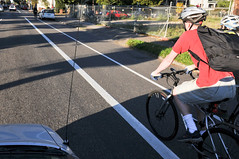If you’re concerned about your personal safety mixing it up with motorized traffic, your fears are not without merit. American roads are made for something powerful, weighty and full of horsepower. Stepping foot or pushing pedal upon them can indeed be daunting.
The tendency for the timid may be to ride on the sidewalk where things feel safer. Although permitted by law and seemingly intuitive, this is a big mistake. Because you are off-road, you are out of the line of sight for drivers and your risk of a collision goes way up (especially going in the opposition direction of adjacent traffic).
On a bicycle, you are safest when you are visible, following standard driving practices and behaving predictably as you ride. This is where bike lanes come in. Bike lanes are engineered to help facilitate predictability and act as a visual cue to separate bikes and cars.

While sometimes controversial and often debated for their safety benefits (or lack thereof), their use is mandated by Oregon law. Let’s take a look:
814.420 Failure to use bicycle lane or path; exceptions; penalty. (1) Except as provided in subsections (2) and (3) of this section, a person commits the offense of failure to use a bicycle lane or path if the person operates a bicycle on any portion of a roadway that is not a bicycle lane or bicycle path when a bicycle lane or bicycle path is adjacent to or near the roadway.
(2) A person is not required to comply with this section unless the state or local authority with jurisdiction over the roadway finds, after public hearing, that the bicycle lane or bicycle path is suitable for safe bicycle use at reasonable rates of speed.
(3) A person is not in violation of the offense under this section if the person is able to safely move out of the bicycle lane or path for the purpose of:
(a) Overtaking and passing another bicycle, a vehicle or a pedestrian that is in the bicycle lane or path and passage cannot safely be made in the lane or path.
(b) Preparing to execute a left turn at an intersection or into a private road or driveway.
(c) Avoiding debris or other hazardous conditions.
(d) Preparing to execute a right turn where a right turn is authorized.
(e) Continuing straight at an intersection where the bicycle lane or path is to the right of a lane from which a motor vehicle must turn right.
(4) The offense described in this section, failure to use a bicycle lane or path, is a Class D traffic violation.
This is pretty straightforward stuff. If there’s a bike lane, you are required to use it unless avoiding a hazard, passing or making a turn. For the hard chargers, those who may even be traveling at the posted speed, you can leave the path to pass someone moving more slowly; but once beyond them, you must surrender the roadway to motorized vehicles and return to the bike lane.
Whether you are a fan of bike lanes or not, they are ensconced in Oregon law. While the law itself could be more clear (as we saw with this interesting test of the law in 2006), it behooves everyone to understand their legal position on the road.
[Editor’s note: Yes, I am are aware that some people feel Oregon’s bike lane law (a.k.a. “mandatory sidepath law”) should be repealed. I think that idea has a lot of merit and I’ll plan to tackle that issue in a separate post.]
— Bike Law 101 appears twice a month thanks to the generous support of West End Bikes PDX (corner of 11th and SW Stark in downtown Portland). It’s written by Karen Lally and Kurt Jansen of the non-profit Animated Traffic Law Center based in Eugene, Oregon. For more info on bike law, browse the Bike Law 101 archives


